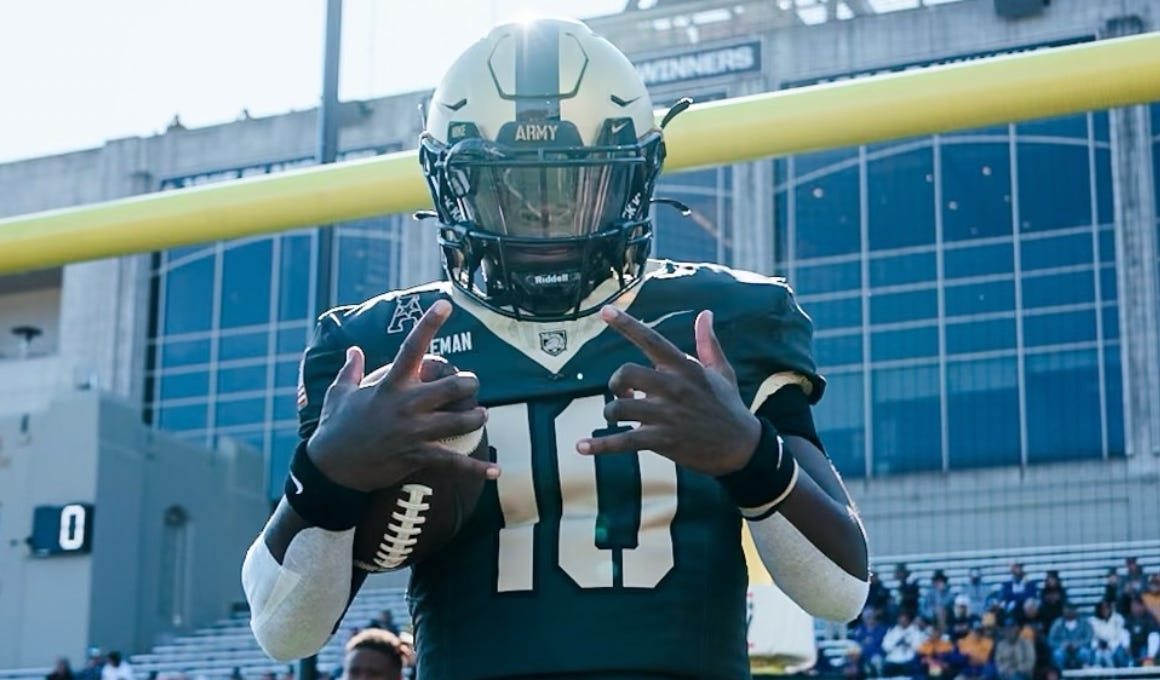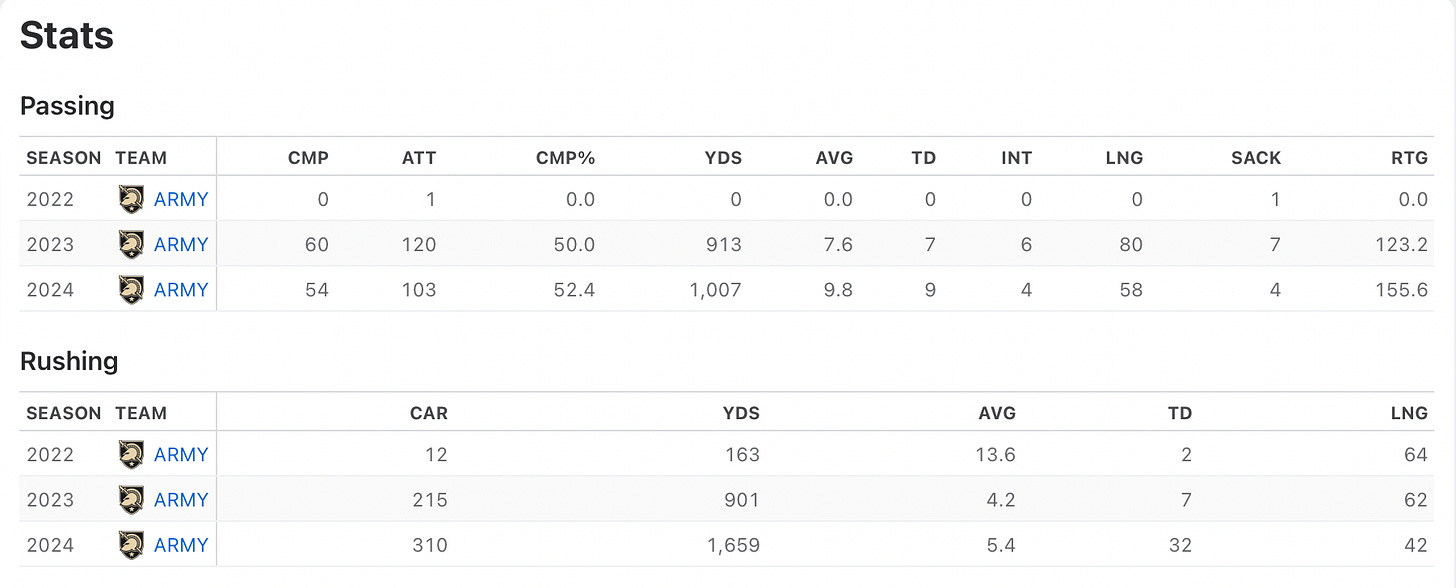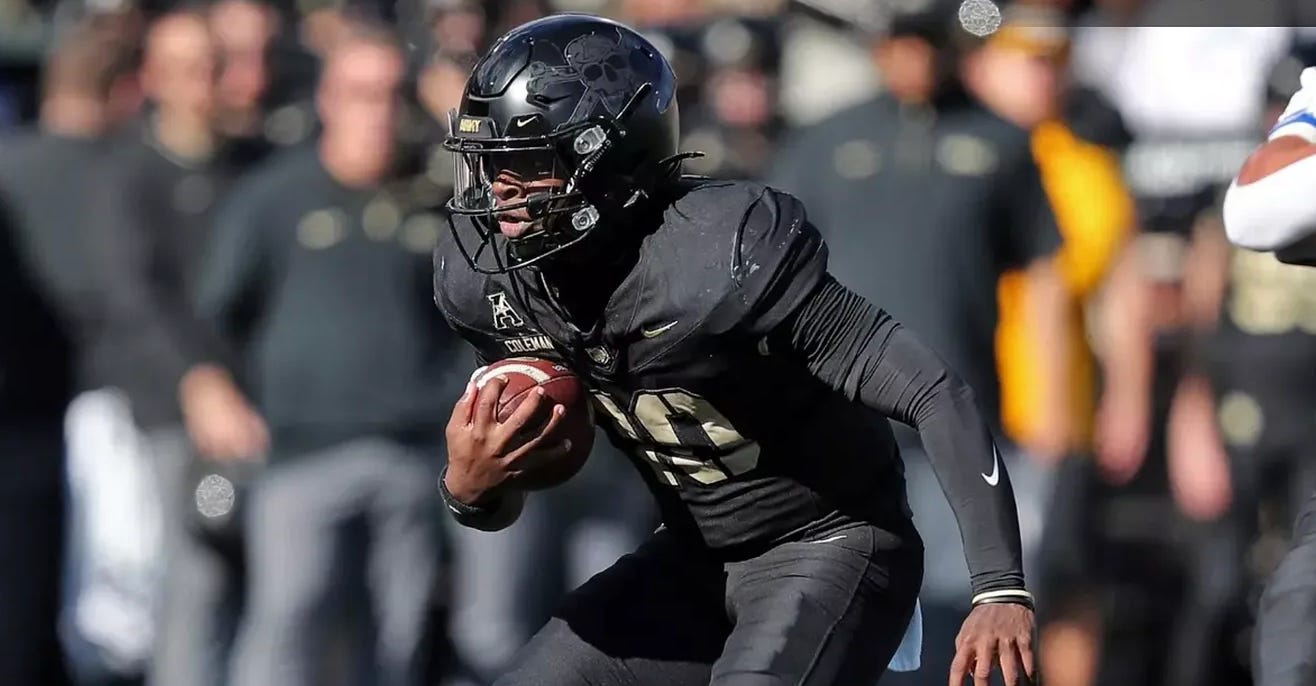Could the Army Academy Have College Football's Most Explosive QB in 2025?
I divide my officers into four classes as follows: the clever, the industrious, the lazy, and the stupid. Each officer always possesses two of these qualities.
Those who are clever and industrious I appoint to the General Staff. Use can, under certain circumstances, be made of those who are stupid and lazy. The man who is clever and lazy qualifies for the highest leadership posts. He has the requisite and the mental clarity for difficult decisions. But whoever is stupid and industrious must be got rid of, for he is too dangerous.
- Kurt von Hammerstein, former military general
What a funky year 2024 was in the world of college ball. For starters, conference realignment dictated that Pacific Coast schools such as USC and Washington were all of a sudden playing routine conference matches vs. schools like Iowa and Minnesota, which still feels completely wrong if you ask me.
Then there was the freshmen wave that absolutely obliterated anything we had seen from a freshmen class before in terms of year one productivity. The wide receiver position, in particular, was outrageous with the likes of Jeremiah Smith and Ryan Williams immediately becoming WR1s at two of CFB’s premier programs. There were many others who achieved similar feats as well (see Cam Coleman at Auburn, the Clemson duo, Joseph Williams at Tulsa…)
But perhaps the most unprecedented phenomenon of the 2024 season was the emergence of highly productive service academy players. I touched on this briefly when I did an article on Navy’s Blake Horvath—in summary, there have a been a handful of productive service academy players scattered through different seasons in the past, but nothing like we saw last season.
Horvath’s counterpart, Army QB Bryson Daily—if I’m not mistaken—finished as CFF’s QB1 on the year in most formats (or at least, a top-three finish). Daily had an incredibly productive 2024 campaign rushing for more yards in one season than he had in his prior two seasons combined.
His CFF finish was a pretty incredible thing considering he barely passed for more than 1000 yards and didn’t even hit double digit passing TDs. One doesn’t have to look far for the answer as to how Daily achieved this—my man punched in a colossal 32 rushing scores on the year off the back of 310 carries. Another 1700ish rushing yards doesn’t hurt either.
But Daily moves on, leaving behind a system that is now of considerable intrigue to CFF drafters following several seasons of neglect. What should we make of this program going forward? Was 2024 just an outlier, or is there real staying power here? Let’s take a look at the infrastructure behind the offence.
Coaching & System
QB1 PPG AVERAGE — HC: 22.7 — OC: 35.71 (half ppr)
I don’t know about you, but the first thing that came to my mind when looking at the above table was: who in the hell is Cody Worley? Turns out this triple option savant has been on staff since 2020. He first joined as the program’s QBs coach, and was then elevated to OC in 2024.
Presumably, his influence was part of the uptick in value of the QB asset in this offence. However, that can’t explain the entirety of the jump in production in my opinion. At least some part of it has to be chalked up to the fact that Daily was an elite runner. My guy was built like a horse, and AAC defenders were NOT capable of bringing him to the ground in the open field.
Still, it is encouraging to at least be able to point to certain factors that can explain the observed shift in trends, especially when some of those factors are still present in the system.
As can be seen from the non-2024 campaigns in the table, Monken’s previous QB1s were not even relevant most years for CFF. The 2018 season is the only other one where the QB averaged over 20 PPG. Not great, Bob.
As expected with a triple-option offence, under Monken Army averages about 85% run plays, and routinely ranks among the slowest offences in all of the FBS with an average of 30 seconds per play. Army averaged a total of 63 plays per game last year, which is in the bottom third of FBS programs.
Along the offensive line, the Black Knights return two fifths of the starters from a year ago.
DeWayne Coleman (5’10, 190)
2024 STATS: 11/16 - 121 -1 (passing) & 38 - 136 -1 (rushing)
When looking at Coleman’s background, it is not surprising that he ended up at the Army academy to play football. In high school, he participated in the U.S. Military Academy Prep School (USMAP), located in San Antonio, for his senior season.
Prior to that, he played at another San Antonio based school called Roosevelt, where he earned All-Area recognition as a football player and achieved summa cum laude honours as a student. He also apparently participated in USMAP camps during his summers prior to enrolling in his senior year.
As typically happens in these academies, Coleman did not see a lot of on-field action during his first two seasons on campus. His first and only start so far in his career came in 2024 in lieu of Bryson Daily, who missed Army’s rivalry contest vs. Air Force. In fact, Coleman became the first Army QB to win his starting debut since the 2020 season.
While it’s hard to judge a player based on a limited sample size, I will say that I wasn’t necessarily ‘wow’d’ by Coleman’s rushing stats, which are the key indicator of whether there will be CFF value here. In his only start vs. AF, Coleman rushed 16 times for 42 yards and zero scores (2.6 ypc). He actually fumbled once but it was recovered by Army.
In every other game of the year, he had single-digit rushing attempts, so I see little use in judging his output stats there.
With Daily, he actually had very solid rushing production the year before his breakout (901 yards and seven scores in 2023). Of course, he was already the starter that year (that helps too). So what may be more illuminating is to look at Daily’s stats prior to starting…
In 2022, he had 12 carries for 163 yards and two scores. Those are pretty similar to Coleman’s last year as a backup; however Daily did this in only four appearances to Coleman’s six. And it should be noted that he outpaced Coleman in yardage despite less carries.
It’s expected that any QB playing in this system should should be a talented runner… otherwise, why are they playing QB in this system in the first place?
Even so, I think it’s safe to say that Daily was a more athletic and gifted runner compared to Coleman. That may not be the take Coleman stans were hoping to read in this CFF article.
On the other hand, another way to look at this situation is: even if Coleman is 70% of Daily (for simplicity, let’s just take 0.7 * 35 PPG) he will still net out to be a solid QB asset in this system averaging around 24 PPG. He’ll be even more valuable in four point passing TD formats given how this system plays offence. ◾
If you enjoyed this content and would like to read more, I recommend joining the Pigpen, a community of thousands of degenerate college football fans:
Sample of 2018-2024, excluding 2020.





